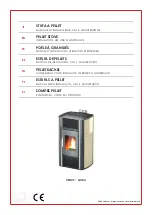
Page 18 of 20
The stove is double glazed; check the rope seals and screws regularly to ensure a long life.
Take care when removing glass clip screws or they could shear
Do not use with broken glass
Do not over tighten the glass clips as this could cause the internal glass to crack.
Only clean the glass when it is cold.
Chimney Sweeping and Maintenance
It may be wise to contact your local chimney sweep before the stove is installed. Your chimney
should be swept at least once a year by a registered sweep, twice a year with heavy use. The
sweep should also replace the fire cement at the base of the flue if necessary.
•
The chimney can be swept through the stove.
•
The stainless steel baffle and top brick should be removed in the reverse order described
on page 14.
•
The baffle should be cleaned at least twice a year with heavy use, checked, renewed as
required and replaced.
•
Unless advised by Burley the stove should not be used with any baffle missing.
•
All rope and glass seals should be checked annually and replaced as necessary.
If the stove has not been used for a prolonged period, in excess of 6 months, the chimney should
be swept prior to use to check for blockages, birds’ nests etc. and rubble/debris blocking the flue
ways.
Safety
NOTE: As with all solid fuel appliances, a carbon monoxide detector should be
purchased for use in the room. All solid fuel appliances produce considerably more
Carbon Monoxide in normal use than oil or gas appliances, but the general ‘smell’ of the
smoke or exhaust is much stronger and more easily detected by a healthy person.
•
Always use your appliance with the door shut and look for tell-tale signs of excessive
leakage: smoke stains above the fireplace, smoke emitting around the door when running,
strong smell of soot upstairs etc.
•
Check the seals at the joints annually and replace the fire cement as required. Check
especially the joint of the flue pipe to the chimney register plate, hairline cracks are OK, but
lumps of cement missing produce a bad joint. A proprietary jointing compound should be
used here, as it is far superior to a cement and rope seal.
•
Never block air vents either internally or externally.
•
Use the supplied glove to reload the stove.
•
In the event of a chimney fire, close the door and shut the air vent right down. If possible
throw ½ cup of course table salt onto the fire.



































